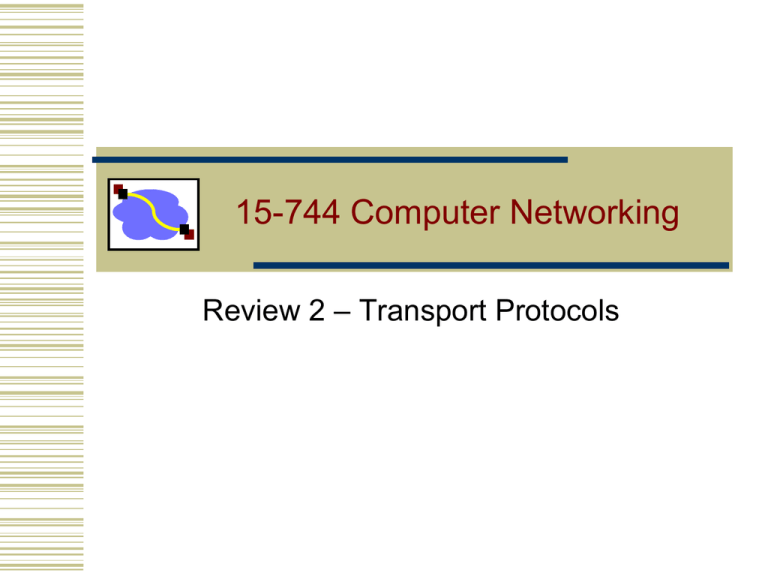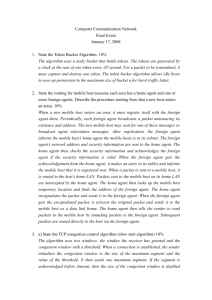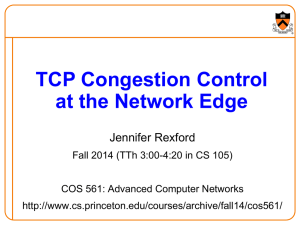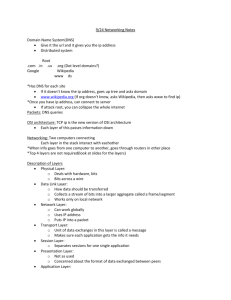15-744 Computer Networking – Transport Protocols Review 2
advertisement

15-744 Computer Networking Review 2 – Transport Protocols Announcements • Project proposal • Due 9/24 • Roughly 1/3 on each of problem statement, state-of-art, work plan/milestones • ~1pg total • HW1 • Out today, due 9/27 2 Outline • Transport introduction • Error recovery & flow control • TCP flow control/connection setup/data transfer • TCP reliability • Congestion sources and collapse • Congestion control basics 3 Transport Protocols • Lowest level end-toend protocol. • Header generated by sender is interpreted only by the destination • Routers view transport header as part of the payload • Not always true… • Firewalls 7 7 6 6 5 5 Transport Transport IP IP IP Datalink 2 2 Datalink Physical 1 1 Physical router 4 Functionality Split • Network provides best-effort delivery • End-systems implement many functions • • • • • • • Reliability In-order delivery Demultiplexing Message boundaries Connection abstraction Congestion control … 5 Transport Protocols • UDP provides just integrity and demux • TCP adds… • • • • • • Connection-oriented Reliable Ordered Byte-stream Full duplex Flow and congestion controlled • DCCP, RTP, SCTP -- not widely used. 6 UDP: User Datagram Protocol [RFC 768] • “No frills,” “bare bones” Internet transport protocol • “Best effort” service, UDP segments may be: • Lost • Delivered out of order to app • Connectionless: Why is there a UDP? • No connection establishment (which can add delay) • Simple: no connection state at sender, receiver • Small header • No congestion control: UDP can blast away as fast as desired • No handshaking between UDP sender, receiver • Each UDP segment handled independently of others 7 UDP, cont. • Often used for streaming multimedia apps • Loss tolerant • Rate sensitive • Other UDP uses (why?): 32 bits Length, in bytes of UDP segment, including header • DNS • Reliable transfer over UDP • Must be at application layer • Application-specific error recovery Source port # Dest port # Length Checksum Application data (message) UDP segment format 8 UDP Checksum Goal: detect “errors” (e.g., flipped bits) in transmitted segment – optional use! Sender: Receiver: • Treat segment contents as sequence of 16-bit integers • Checksum: addition (1’s complement sum) of segment contents • Sender puts checksum value into UDP checksum field • Compute checksum of received segment • Check if computed checksum equals checksum field value: • NO - error detected • YES - no error detected But maybe errors nonetheless? 9 High-Level TCP Characteristics • Protocol implemented entirely at the ends • Fate sharing (on IP) • Protocol has evolved over time and will continue to do so • • • • Nearly impossible to change the header Use options to add information to the header Change processing at endpoints Backward compatibility is what makes it TCP 10 TCP Header Source port Destination port Sequence number Flags: SYN FIN RESET PUSH URG ACK Acknowledgement HdrLen 0 Flags Advertised window Checksum Urgent pointer Options (variable) Data 11 Evolution of TCP 1984 Nagel’s algorithm to reduce overhead of small packets; predicts congestion collapse 1975 Three-way handshake Raymond Tomlinson In SIGCOMM 75 1983 BSD Unix 4.2 supports TCP/IP 1974 TCP described by Vint Cerf and Bob Kahn In IEEE Trans Comm 1986 Congestion collapse observed 1982 TCP & IP RFC 793 & 791 1975 1980 1987 Karn’s algorithm to better estimate round-trip time 1985 1990 4.3BSD Reno fast retransmit delayed ACK’s 1988 Van Jacobson’s algorithms congestion avoidance and congestion control (most implemented in 4.3BSD Tahoe) 1990 12 TCP Through the 1990s 1994 T/TCP (Braden) Transaction TCP 1993 1994 TCP Vegas ECN (Brakmo et al) (Floyd) delay-based Explicit congestion avoidance Congestion Notification 1993 1994 1996 SACK TCP (Floyd et al) Selective Acknowledgement 1996 Hoe NewReno startup and loss recovery 1996 FACK TCP (Mathis et al) extension to SACK 1996 13 Outline • Transport introduction • Error recovery & flow control • TCP flow control/connection setup/data transfer • TCP reliability • Congestion sources and collapse • Congestion control basics 14 Stop and Wait • ARQ • Receiver sends acknowledgement (ACK) when it receives packet • Sender waits for ACK and timeouts if it does not arrive within some time period Receiver Timeout • Simplest ARQ protocol • Send a packet, stop and wait until ACK arrives • Performance • Can only send one packet per round trip Sender Time 15 ACK lost Timeout Timeout Timeout Timeout Timeout Time Timeout Recovering from Error Packet lost Early timeout DUPLICATE PACKETS!!! 16 How to Recognize Resends? • Use sequence numbers • both packets and acks • Sequence # in packet is finite How big should it be? • For stop and wait? • One bit – won’t send seq #1 until received ACK for seq #0 17 How to Keep the Pipe Full? • Send multiple packets without waiting for first to be acked • Number of pkts in flight = window: Flow control • Reliable, unordered delivery • Several parallel stop & waits • Send new packet after each ack • Sender keeps list of unack’ed packets; resends after timeout • Receiver same as stop & wait • How large a window is needed? • Suppose 10Mbps link, 4ms delay, 500byte pkts • 1? 10? 20? • Round trip delay * bandwidth = capacity of pipe 18 Sliding Window • Reliable, ordered delivery • Receiver has to hold onto a packet until all prior packets have arrived • Why might this be difficult for just parallel stop & wait? • Sender must prevent buffer overflow at receiver • Circular buffer at sender and receiver • Packets in transit buffer size • Advance when sender and receiver agree packets at beginning have been received 19 Sender/Receiver State Sender Max ACK received Receiver Next expected Next seqnum … … … … Sender window Sent & Acked Sent Not Acked OK to Send Not Usable Max acceptable Receiver window Received & Acked Acceptable Packet Not Usable 20 Sequence Numbers • How large do sequence numbers need to be? • Must be able to detect wrap-around • Depends on sender/receiver window size • E.g. • Max seq = 7, send win=recv win=7 • If pkts 0..6 are sent succesfully and all acks lost • Receiver expects 7,0..5, sender retransmits old 0..6!!! • Max sequence must be send window + recv window 21 Window Sliding – Common Case • On reception of new ACK (i.e. ACK for something that was not acked earlier) • Increase sequence of max ACK received • Send next packet • On reception of new in-order data packet (next expected) • Hand packet to application • Send cumulative ACK – acknowledges reception of all packets up to sequence number • Increase sequence of max acceptable packet 22 Loss Recovery • On reception of out-of-order packet • Send nothing (wait for source to timeout) • Cumulative ACK (helps source identify loss) • Timeout (Go-Back-N recovery) • Set timer upon transmission of packet • Retransmit all unacknowledged packets • Performance during loss recovery • No longer have an entire window in transit • Can have much more clever loss recovery 23 Important Lessons • Transport service • UDP mostly just IP service • TCP congestion controlled, reliable, byte stream • Types of ARQ protocols • Stop-and-wait slow, simple • Go-back-n can keep link utilized (except w/ losses) • Selective repeat efficient loss recovery -- used in SACK • Sliding window flow control • Addresses buffering issues and keeps link utilized 24 Good Ideas So Far… • Flow control • Stop & wait • Parallel stop & wait • Sliding window • Loss recovery • Timeouts • Acknowledgement-driven recovery (selective repeat or cumulative acknowledgement) 25 Outline • Transport introduction • Error recovery & flow control • TCP flow control/connection setup/data transfer • TCP reliability • Congestion sources and collapse • Congestion control basics 26 More on Sequence Numbers • 32 Bits, Unsigned for bytes not packets! • Why So Big? • For sliding window, must have • |Sequence Space| > |Sending Window| + |Receiving Window| • No problem • Also, want to guard against stray packets • With IP, packets have maximum lifetime of 120s • Sequence number would wrap around in this time at 286Mbps 27 TCP Flow Control • TCP is a sliding window protocol • For window size n, can send up to n bytes without receiving an acknowledgement • When the data is acknowledged then the window slides forward • Each packet advertises a window size • Indicates number of bytes the receiver has space for • Original TCP always sent entire window • Congestion control now limits this 28 Window Flow Control: Send Side window Sent and acked Sent but not acked Not yet sent Next to be sent 29 Window Flow Control: Send Side Packet Sent Source Port Dest. Port Packet Received Source Port Dest. Port Sequence Number Sequence Number Acknowledgment Acknowledgment HL/Flags Window HL/Flags Window D. Checksum Urgent Pointer D. Checksum Urgent Pointer Options… Options... App write acknowledged sent to be sent outside window 30 Performance Considerations • The window size can be controlled by receiving application • Can change the socket buffer size from a default (e.g. 8Kbytes) to a maximum value (e.g. 64 Kbytes) • The window size field in the TCP header limits the window that the receiver can advertise • • • • 16 bits 64 KBytes 10 msec RTT 51 Mbit/second 100 msec RTT 5 Mbit/second TCP options to get around 64KB limit scales window size 31 Establishing Connection: Three-Way handshake • Each side notifies other of starting sequence number it will use for sending SYN: SeqC • Why not simply chose 0? • Must avoid overlap with earlier incarnation • Security issues ACK: SeqC+1 SYN: SeqS • Each side acknowledges other’s sequence number ACK: SeqS+1 • SYN-ACK: Acknowledge sequence number + 1 • Can combine second SYN with first ACK Client Server 32 Outline • Transport introduction • Error recovery & flow control • TCP flow control/connection setup/data transfer • TCP reliability • Congestion sources and collapse • Congestion control basics 33 Reliability Challenges • Congestion related losses • Variable packet delays • What should the timeout be? • Reordering of packets • How to tell the difference between a delayed packet and a lost one? 34 TCP = Go-Back-N Variant • Sliding window with cumulative acks • Receiver can only return a single “ack” sequence number to the sender. • Acknowledges all bytes with a lower sequence number • Starting point for retransmission • Duplicate acks sent when out-of-order packet received • But: sender only retransmits a single packet. • Reason??? • Only one that it knows is lost • Network is congested shouldn’t overload it • Error control is based on byte sequences, not packets. • Retransmitted packet can be different from the original lost packet – Why? 35 Round-trip Time Estimation • Wait at least one RTT before retransmitting • Importance of accurate RTT estimators: • Low RTT estimate • unneeded retransmissions • High RTT estimate • poor throughput • RTT estimator must adapt to change in RTT • But not too fast, or too slow! • Spurious timeouts • “Conservation of packets” principle – never more than a window worth of packets in flight 36 Original TCP Round-trip Estimator • Round trip times exponentially averaged: • New RTT = a (old RTT) + (1 - a) (new sample) • Recommended value for a: 0.8 - 0.9 • 0.875 for most TCP’s 2.5 2 1.5 1 0.5 0 • Retransmit timer set to (b * RTT), where b = 2 • Every time timer expires, RTO exponentially backed-off • Not good at preventing premature timeouts 37 Jacobson’s Retransmission Timeout • Key observation: • At high loads round trip variance is high • Solution: • Base RTO on RTT and standard deviation • RTO = RTT + 4 * rttvar • new_rttvar = b * dev + (1- b) old_rttvar • Dev = linear deviation • Inappropriately named – actually smoothed linear deviation 39 Timestamp Extension • Used to improve timeout mechanism by more accurate measurement of RTT • When sending a packet, insert current time into option • 4 bytes for time, 4 bytes for echo a received timestamp • Receiver echoes timestamp in ACK • Actually will echo whatever is in timestamp • Removes retransmission ambiguity • Can get RTT sample on any packet 40 Timer Granularity • Many TCP implementations set RTO in multiples of 200,500,1000ms • Why? • Avoid spurious timeouts – RTTs can vary quickly due to cross traffic • Reduce timer expensive timer interrupts on hosts • What happens for the first couple of packets? • Pick a very conservative value (seconds) 41 Fast Retransmit -- Avoiding Timeouts • What are duplicate acks (dupacks)? • Repeated acks for the same sequence • When can duplicate acks occur? • Loss • Packet re-ordering • Window update – advertisement of new flow control window • Assume re-ordering is infrequent and not of large magnitude • Use receipt of 3 or more duplicate acks as indication of loss • Don’t wait for timeout to retransmit packet 42 Fast Retransmit X Retransmission Duplicate Acks Sequence No Packets Acks Time 43 TCP (Reno variant) X X X Now what? - timeout X Sequence No Packets Acks Time 44 SACK • Basic problem is that cumulative acks provide little information • Selective acknowledgement (SACK) essentially adds a bitmask of packets received • Implemented as a TCP option • Encoded as a set of received byte ranges (max of 4 ranges/often max of 3) • When to retransmit? • Still need to deal with reordering wait for out of order by 3pkts 45 SACK X X X X Sequence No Now what? – send retransmissions as soon as detected Packets Acks Time 46 Performance Issues • Timeout >> fast rexmit • Need 3 dupacks/sacks • Not great for small transfers • Don’t have 3 packets outstanding • What are real loss patterns like? 47 Important Lessons • Three-way TCP Handshake • TCP timeout calculation how is RTT estimated • Modern TCP loss recovery • Why are timeouts bad? • How to avoid them? e.g. fast retransmit 48 Outline • Transport introduction • Error recovery & flow control • TCP flow control/connection setup/data transfer • TCP reliability • Congestion sources and collapse • Congestion control basics 49 Congestion 10 Mbps 1.5 Mbps 100 Mbps • Different sources compete for resources inside network • Why is it a problem? • Sources are unaware of current state of resource • Sources are unaware of each other • In many situations will result in < 1.5 Mbps of throughput (congestion collapse) 50 Causes & Costs of Congestion • Four senders – multihop paths • Timeout/retransmit Q: What happens as rate increases? 51 Causes & Costs of Congestion • When packet dropped, any “upstream transmission capacity used for that packet was wasted! 52 Congestion Collapse • Definition: Increase in network load results in decrease of useful work done • Many possible causes • Spurious retransmissions of packets still in flight • Classical congestion collapse • How can this happen with packet conservation • Solution: better timers and TCP congestion control • Undelivered packets • Packets consume resources and are dropped elsewhere in network • Solution: congestion control for ALL traffic • Etc.. 53 Where to Prevent Collapse? • Can end hosts prevent problem? • Yes, but must trust end hosts to do right thing • E.g., sending host must adjust amount of data it puts in the network based on detected congestion • Can routers prevent collapse? • No, not all forms of collapse • Doesn’t mean they can’t help • Sending accurate congestion signals • Isolating well-behaved from ill-behaved sources 55 Congestion Control and Avoidance • A mechanism which: • Uses network resources efficiently • Preserves fair network resource allocation • Prevents or avoids collapse • Congestion collapse is not just a theory • Has been frequently observed in many networks 56 Approaches For Congestion Control • Two broad approaches towards congestion control: End-to-end • No explicit feedback from network • Congestion inferred from end-sys tem observed loss, delay • Approach taken by TCP Network-assisted • Routers provide feedback to end systems • Explicit rate sender should send at • Single bit indicating congestion (SNA, DEC bit, TCP/IP ECN, ATM) • Problem: makes routers complicated 57 Example: TCP Congestion Control • Very simple mechanisms in network • FIFO scheduling with shared buffer pool • Feedback through packet drops • TCP interprets packet drops as signs of congestion and slows down • This is an assumption: packet drops are not a sign of congestion in all networks • E.g. wireless networks • Periodically probes the network to check whether more bandwidth has become available. 58 Outline • Transport introduction • Error recovery & flow control • TCP flow control/connection setup/data transfer • TCP reliability • Congestion sources and collapse • Congestion control basics 59 Objectives • • • • • • Simple router behavior Distributedness Efficiency: Xknee = Sxi(t) Fairness: (Sxi)2/n(Sxi2) Power: (throughputa/delay) Convergence: control system must be stable 60 Basic Control Model • Let’s assume window-based control • Reduce window when congestion is perceived • How is congestion signaled? • Either mark or drop packets • When is a router congested? • Drop tail queues – when queue is full • Average queue length – at some threshold • Increase window otherwise • Probe for available bandwidth – how? 61 Linear Control • Many different possibilities for reaction to congestion and probing • Examine simple linear controls • Window(t + 1) = a + b Window(t) • Different ai/bi for increase and ad/bd for decrease • Supports various reaction to signals • Increase/decrease additively • Increased/decrease multiplicatively • Which of the four combinations is optimal? 62 Phase plots • Simple way to visualize behavior of competing connections over time Fairness Line User 2’s Allocation x2 Efficiency Line User 1’s Allocation x1 63 Phase plots • What are desirable properties? • What if flows are not equal? Fairness Line Overload User 2’s Allocation x2 Optimal point Underutilization Efficiency Line User 1’s Allocation x1 64 Additive Increase/Decrease • Both X1 and X2 increase/decrease by the same amount over time • Additive increase improves fairness and additive decrease reduces fairness Fairness Line T1 User 2’s Allocation x2 T0 Efficiency Line User 1’s Allocation x1 65 Multiplicative Increase/Decrease • Both X1 and X2 increase by the same factor over time • Extension from origin – constant fairness Fairness Line T1 User 2’s Allocation x2 T0 Efficiency Line User 1’s Allocation x1 66 Convergence to Efficiency Fairness Line xH User 2’s Allocation x2 Efficiency Line User 1’s Allocation x1 67 Distributed Convergence to Efficiency a=0 b=1 Fairness Line xH User 2’s Allocation x2 Efficiency Line User 1’s Allocation x1 68 Convergence to Fairness Fairness Line xH User 2’s Allocation x2 xH’ Efficiency Line User 1’s Allocation x1 69 Convergence to Efficiency & Fairness Fairness Line xH User 2’s Allocation x2 xH’ Efficiency Line User 1’s Allocation x1 70 Increase Fairness Line User 2’s Allocation x2 xL Efficiency Line User 1’s Allocation x1 71 Constraints • Distributed efficiency • I.e., S Window(t+1) > S Window(t) during increase • ai > 0 & bi ≥ 1 • Similarly, ad < 0 & bd ≤ 1 • Must never decrease fairness • a & b’s must be ≥ 0 • ai/bi > 0 and ad/bd ≥ 0 • Full constraints • ad = 0, 0 ≤ bd < 1, ai > 0 and bi ≥ 1 72 What is the Right Choice? • Constraints limit us to AIMD • Can have multiplicative term in increase (MAIMD) • AIMD moves towards optimal point Fairness Line x1 User 2’s Allocation x2 x0 x2 Efficiency Line User 1’s Allocation x1 73 Questions • Fairness – why not support skew AIMD/GAIMD analysis • More bits of feedback DECbit, XCP, Vegas • Guess # of users hard in async system, look at loss rate? • Stateless vs. stateful design • Wired vs. wireless • Non-linear controls Bionomial 74 TCP Congestion Control • Congestion Control • RED • Assigned Reading • [FJ93] Random Early Detection Gateways for Congestion Avoidance • [TFRC] Equation-Based Congestion Control for Unicast Applications 75






